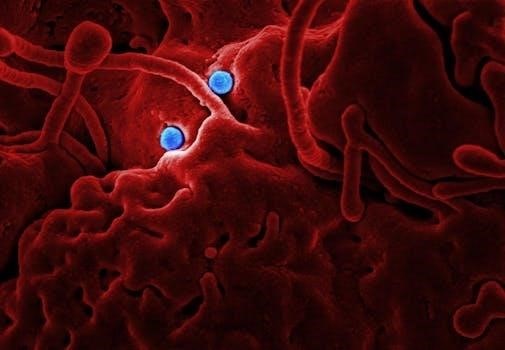Cell Organelles⁚ An Overview
Cell organelles are specialized structures within cells, each performing distinct functions vital for life. These structures, like tiny organs within the cell, collaborate to maintain cellular processes, ensuring the cell’s survival and proper function. They include both membrane-bound and non-membrane-bound components.
Eukaryotic vs. Prokaryotic Cell Components
Both eukaryotic and prokaryotic cells share fundamental components like a plasma membrane, cytoplasm, and ribosomes; however, significant differences distinguish them. Eukaryotic cells are generally larger and possess a true nucleus, where their DNA is enclosed within a membrane. In contrast, prokaryotic cells lack a membrane-bound nucleus; their DNA resides in the cytoplasm. Eukaryotic cells boast a more complex internal structure, featuring membrane-bound organelles, such as the endoplasmic reticulum, Golgi apparatus, and mitochondria, which are absent in prokaryotic cells. These organelles enable eukaryotic cells to perform a wider array of functions, including complex metabolic processes and compartmentalization of cellular activities. Prokaryotic cells, while simpler, still efficiently carry out essential life functions, relying on a less intricate internal organization. The presence or absence of membrane-bound organelles is a key characteristic separating these two cell types, reflecting their evolutionary divergence and functional adaptations. The cytoskeleton matrix is present in both, but it is more complex in eukaryotic cells. Understanding these distinctions is crucial for comprehending the diversity and complexity of life.

Membrane-Bound Organelles
Membrane-bound organelles are specialized compartments within eukaryotic cells, each enclosed by a lipid bilayer. These structures perform specific functions, such as energy production, protein processing, and waste management. They are essential for compartmentalizing cellular activities within the cell.
Nucleus⁚ Control Center of the Cell
The nucleus, a prominent double-membrane-bound organelle, is the control center of eukaryotic cells, housing the cell’s DNA. It’s the largest organelle, easily visible under a microscope. The nucleus is enclosed by a porous nuclear membrane, separating it from the cytoplasm. Within the nucleus, there are tiny spherical bodies called nucleoli, crucial for protein and RNA synthesis. The nucleus contains chromosomes, thin, thread-like structures carrying genes. Genes are the hereditary units that facilitate the transfer of traits from parents to offspring. The nucleus monitors cellular activities, including metabolism and growth, by utilizing the genetic information encoded in DNA. The nuclear membrane acts as a barrier regulating the movement of molecules between the nucleus and cytoplasm. The nucleus dictates the cell’s characteristics and functions, effectively controlling cellular operations. The nucleoli within the nucleus are the sites of ribosome assembly. The nucleus, therefore, plays a central role in the cell’s life cycle, ensuring the proper functioning and inheritance of genetic information.
Mitochondria⁚ The Powerhouse of the Cell
Mitochondria, often called the powerhouses of the cell, are double-membrane-bound organelles found in almost all eukaryotic cells. They are responsible for generating energy-rich molecules, primarily ATP, through cellular respiration. These sausage-shaped organelles have an outer membrane that forms a continuous boundary with the cytoplasm and an inner membrane folded into cristae, increasing the surface area for energy production. The space between the membranes is divided into two distinct compartments⁚ the intermembrane space and the matrix. The matrix contains its own circular DNA, RNA, and ribosomes (70s), indicating a degree of autonomy. Mitochondria convert glucose into ATP, the cell’s primary energy currency. They participate in aerobic respiration, a process essential for the cell’s energy needs. These organelles vary in size and shape, but their key function remains energy production. Inherited maternally, mitochondrial DNA plays a significant role in cell functioning. They are essential for cellular metabolism and the transformation of molecules, providing the energy that fuels cell activities.
Endoplasmic Reticulum⁚ Cellular Transport Network
The Endoplasmic Reticulum (ER) is a vast network of membranous canals that extend throughout the cytoplasm of eukaryotic cells. Serving as the cell’s transport system, the ER facilitates the movement of materials across the cell. There are two main types of ER⁚ the rough endoplasmic reticulum (RER), studded with ribosomes, and the smooth endoplasmic reticulum (SER), lacking ribosomes. The RER is primarily involved in protein synthesis and modification, while the SER plays a crucial role in lipid and steroid synthesis, as well as detoxification processes. The ER’s interconnected network of tubules and sacs creates a pathway for molecules to move from one part of the cell to another. This transport system is vital for the cell’s efficient functioning, enabling the distribution of synthesized products to their appropriate destinations. The ER also plays a crucial role in calcium storage and release, which is essential for cell signaling; In essence, the endoplasmic reticulum is a dynamic and versatile organelle involved in many cellular processes.
Golgi Apparatus⁚ Protein Processing and Packaging

The Golgi apparatus, also known as the Golgi complex, is a membrane-bound organelle found in eukaryotic cells. It consists of a series of flattened, stacked pouches called cisternae. The Golgi apparatus plays a crucial role in modifying, sorting, and packaging proteins and lipids for transport to other parts of the cell or for secretion outside the cell. Proteins synthesized in the endoplasmic reticulum are transported to the Golgi, where they undergo further processing. This can include glycosylation, the addition of sugar molecules, and other modifications. The Golgi apparatus sorts these processed molecules into transport vesicles, which bud off from the Golgi and carry their contents to specific destinations. The Golgi apparatus acts as a central hub for processing and directing cellular materials, ensuring that proteins and lipids are delivered to the correct locations. It is essential for the proper functioning and organization of the cell, contributing to various cellular processes such as protein trafficking and secretion. It is present in both plant and animal cells, highlighting its universal importance.

Non-Membrane Bound Organelles
Non-membrane bound organelles lack a surrounding lipid bilayer. These structures, such as ribosomes and the cytoskeleton, are essential for cell function. They are found in both prokaryotic and eukaryotic cells, playing key roles in protein synthesis and structural support.
Ribosomes⁚ Protein Synthesis Factories
Ribosomes are non-membrane bound organelles, essential for protein synthesis in all living cells. They are found in large numbers within the cell, often associated with the endoplasmic reticulum or freely floating in the cytoplasm. Composed of ribosomal RNA (rRNA) and proteins, ribosomes are crucial for translating genetic code into functional proteins. They are made up of two subunits, which come together during protein synthesis. In prokaryotic cells, ribosomes are termed 70S, while in eukaryotic cells they are 80S, with the ‘S’ referring to Svedberg units, indicating their density and size.

These tiny particles act as the workbenches where amino acids are linked together to form polypeptide chains. Ribosomes receive instructions from messenger RNA (mRNA), which carries the genetic code from DNA. They then match transfer RNA (tRNA) molecules with their respective amino acids to the mRNA codons, assembling the protein molecule in the correct sequence. This process is fundamental to the cell’s survival, ensuring a constant supply of proteins needed for various cellular functions. Without ribosomes, cells wouldn’t be able to produce the enzymes, structural proteins, and other molecules they need to live and function effectively. The synthesis of these proteins is vital for all cellular activities, from growth and repair to metabolism and signaling.
Leave a Reply
You must be logged in to post a comment.